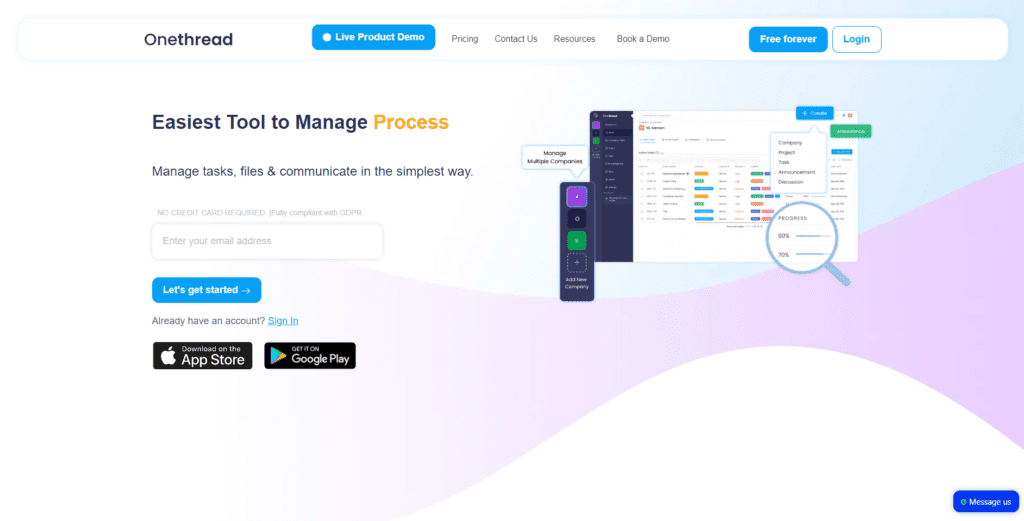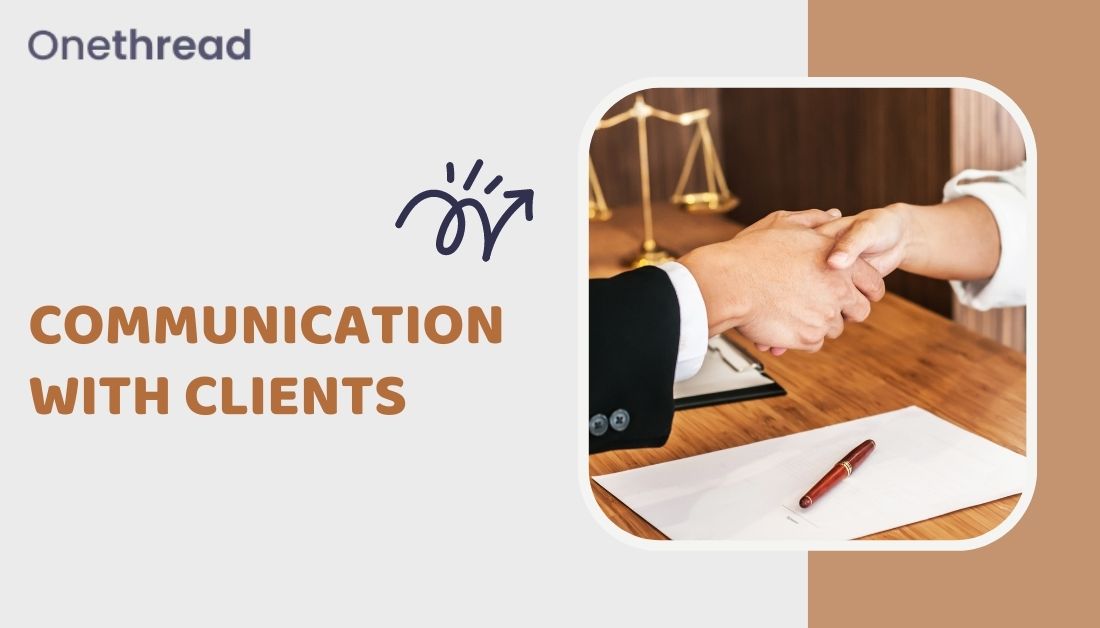Effective communication is vital in any professional setting, especially with clients. As a business professional, your ability to communicate with clients can significantly impact your success and reputation.
Strong client communication skills are essential for building trust, understanding client needs, and fostering long-term relationships. This article will explore top client communication skills to help you become a star communicator and excel professionally.
What is client communication?
Client communication is all about connecting and engaging with your valued clients. It’s the art of exchanging information, ideas, and messages in a way that fosters strong relationships.
Whether it’s chatting face-to-face, sending emails, or having phone conversations, client communication is about understanding their needs, addressing their questions and worries, and keeping them informed.
We aim to build trust, make clients happy, and work together toward success by having open and transparent conversations. So, let’s dive in and explore the wonderful world of client communication!
The Power of Effective Client Communication

Effective client communication is a critical aspect of any successful business. It is pivotal in building solid relationships, ensuring client satisfaction, and fostering long-term loyalty. This article will delve into the significance of effective client communication and explore how it can positively impact your business.
Building Trust and Rapport
Clear and transparent communication is the foundation of trust between clients and businesses. When you communicate effectively with your clients, you demonstrate your reliability, professionalism, and dedication to meeting their needs. Trust is essential for establishing long-term relationships, fostering repeat business, and gaining referrals.
Understanding Client Needs
Effective client communication lets you deeply understand your client’s needs, preferences, and expectations.
By actively listening and engaging in meaningful conversations, you can uncover valuable insights that enable you to tailor your products, services, and solutions to meet their specific requirements. This understanding sets the stage for delivering exceptional customer experiences.
Managing Expectations
Open and honest communication is critical to managing client expectations. By clearly communicating project timelines, deliverables, and potential challenges, you can ensure clients have realistic expectations, from help prevent misunderstandings, frustrations, and potential conflicts down the line. In addition, when clients clearly understand what to expect, they are more likely to be satisfied with the outcomes.
Resolving Issues and Concerns
Effective client communication is crucial for addressing and resolving any issues or concerns that may arise. Promptly addressing client complaints or feedback shows that you value their opinions and are committed to finding solutions.
By maintaining open lines of communication, you can quickly identify and rectify any issues, thereby strengthening the client’s trust and satisfaction.
Enhancing Collaboration
Strong client communication fosters collaboration and teamwork. When you establish clear communication channels, you encourage clients to participate in the decision-making process actively.
By seeking their input, involving them in discussions, and keeping them informed about project progress, you create a collaborative atmosphere that leads to better outcomes and a sense of ownership for all parties involved.
Providing Exceptional Customer Service
Effective communication is at the heart of delivering exceptional customer service. Clients who feel heard, understood, and valued will perceive your business positively.
By promptly responding to inquiries, providing accurate information, and maintaining regular communication, you demonstrate your commitment to their satisfaction. Exceptional customer service sets you apart from competitors and cultivates loyal, long-term client relationships.
Achieving Business Growth
Effective client communication directly impacts your bottom line. Satisfied clients are more likely to become repeat customers and refer your business to others. In addition, positive word-of-mouth recommendations can significantly contribute to business growth.
Additionally, by actively seeking client feedback and using it to improve your offerings, you can attract new clients and expand your customer base.
Essential client communication skills
Client communication skills encompass a combination of linguistic proficiency, interpersonal aptitude, and emotional intelligence that empower individuals to engage in clear, meaningful, and emotionally considerate conversations with clients.
In client communication, it is not uncommon for interactions to encounter hurdles and pitfalls, leading to potential misunderstandings. However, a skilled communicator possesses the expertise to navigate these communication challenges adeptly, leaving minimal room for errors.
The distinguishing characteristics of a proficient communicator can be observed through the following elements exhibited in their conversations:
Active Listening
One of the most fundamental skills in client communication is active listening. It involves giving full attention to the client, understanding their concerns, and responding appropriately. Active listening requires focusing on what the client is saying, asking relevant questions, and providing thoughtful responses.
By actively listening, you demonstrate empathy and show clients that their opinions and needs are valued.
Clarity and Conciseness
Clear and concise communication is crucial when dealing with clients. Avoid jargon, complex terminology, or excessive technical details that may confuse or overwhelm the client. Instead, convey your messages in a straightforward and easily understandable manner.
Use plain language to explain concepts and provide clear instructions. Being concise in your communication demonstrates professionalism and helps prevent misunderstandings.
Empathy and Understanding
Clients appreciate professionals who can empathize with their challenges and understand their perspectives. Put yourself in their shoes, and try to view situations from their point of view. Show genuine interest in their concerns, validate their emotions, and provide reassurance. Empathetic communication helps build trust, fosters more robust relationships, and enhances client satisfaction.
Adaptability
Each client is unique, with varying communication preferences and styles. Adaptability in your communication approach is essential to cater to different client needs. Pay attention to their preferred communication channels: email, phone calls, or in-person meetings.
Adapt your tone, style, and pace of communication to match theirs. Flexibility in your touch demonstrates your willingness to accommodate their preferences, resulting in smoother interactions.
Timely and Responsive Communication
Prompt and timely communication is a crucial aspect of effective client management. Therefore, respond promptly to client inquiries, emails, and messages, acknowledging receipt of their communication.
Even if you don’t have an immediate solution or answer, let the client know you are working on it and will get back to them within a specific timeframe. Consistent and responsive communication shows your commitment to providing excellent client service.
Problem-Solving Skills
Clients often approach professionals seeking solutions to their problems. Therefore, demonstrating strong problem-solving skills is crucial in client communication. Actively engage with clients to understand their challenges and work collaboratively to find practical solutions.
Present your ideas and recommendations clearly, providing supporting information or examples where necessary. Effective problem-solving builds trust and credibility with clients, positioning you as a reliable resource.
Diplomacy and Professionalism
Maintaining professionalism and diplomacy in client communication is paramount, even during challenging situations. Remain calm and composed, even when confronted with demanding clients or complex issues. Choose your words carefully, ensuring that they are respectful and appropriate.
Focus on finding solutions rather than getting caught up in conflicts. Diplomatic communication helps preserve relationships and showcases your professionalism.
Critical Strategies for Enhancing Client Communication

Strategy 1: Establish an Emotional Connection with the Client
Building an emotional connection with your clients is essential for establishing trust and fostering a strong working relationship. It is essential to show empathy, understanding, and genuine interest in their needs and concerns.
Take the time to get to know your clients personally, actively listen to their challenges and demonstrate that you genuinely care about their success. This emotional connection will help you establish rapport, enhance client loyalty, and create a positive communication environment.
Strategy 2: Ensure Concise, Clear, and Context-Driven Communication
Effective communication is concise, clear, and tailored to the specific context. When communicating with clients, conveying your message concisely and straightforwardly is crucial. Avoid jargon or technical terms that may confuse or alienate your clients.
Adapt your communication style to suit their level of understanding and provide relevant examples or visuals to enhance clarity. Additionally, consider the context of your communication, such as the medium (email, phone, in-person), the client’s preferences, and any specific project requirements.
Strategy 3: Maintain a Positive Tone
The tone of your communication significantly impacts the client’s perception of your professionalism and the overall relationship. Therefore, always maintain a positive and professional style, even during challenging or stressful situations.
Use polite and respectful language, and avoid sounding condescending or dismissive. If there are any conflicts or disagreements, address them calmly and constructively, focusing on finding solutions rather than placing blame. A positive tone fosters open communication, trust, and client collaboration.
Strategy 4: Utilize Emphasis and Subordination Appropriately
To effectively convey your message and highlight key points, it’s vital to use emphasis and subordination appropriately. Emphasize important information, such as project milestones, deadlines, or critical updates, by using techniques like bold or italicized text, headings, or bullet points.
This helps draw attention and ensures that crucial details are noticed. On the other hand, subordinate less critical information by providing additional context or placing it in supporting paragraphs. This helps maintain a clear and organized communication flow.
Strategy 5: Be an Active Listener
Being an active listener is crucial in client communication. It involves entirely focusing on the client’s words, understanding their perspective, and responding appropriately. Avoid interrupting or jumping to conclusions prematurely.
Instead, listen attentively, ask clarifying questions to ensure understanding, and paraphrase or summarize their points to demonstrate active engagement. This shows respect for the client’s opinions and allows you to gather valuable insights and respond effectively to their needs.
Strategy 6: Utilize a Client Communication Tool
Using a client communication tool can significantly enhance your communication efficiency and effectiveness. These tools provide a centralized platform for communication, allowing you to organize discussions, share files, track progress, and collaborate seamlessly with your clients.
They also help ensure critical information and updates are accessible to all relevant stakeholders. Choose a communication tool that aligns with your client’s preferences and needs, and leverage its features to streamline communication and improve overall client satisfaction.
By implementing these strategies, you can establish strong client relationships, foster effective communication, and ensure mutual project understanding and success.
Must-Have Software Features for Seamless Client Communication

Smooth Onboarding Experience
Getting started with client communication software should be a breeze. Look for a tool that allows you to effortlessly create accounts for all the stakeholders on the client side. Whether through a convenient CSV import option or a user-friendly self-registration process, ensure the software offers a hassle-free onboarding experience.
Efficient Collaboration Among Multiple Users
Client meetings often involve multiple individuals from both your team and the client’s team. Therefore, choosing a communication tool that facilitates seamless collaboration among these various stakeholders is essential. In addition, the software should enable your team and the client’s team to connect and exchange information effortlessly without complications.
Email and Mobile Notifications for Instant Updates
Your client communication tool should keep you informed, like how you receive email notifications and mobile app pings for missed chat messages on LinkedIn. Ensure the software sends email notifications whenever an update or important information is shared with the client.
Additionally, instant mobile push notifications will prove incredibly useful for staying updated on the go.
Effortless Client Feedback Capture
An ideal client communication tool should provide convenient features such as annotations, comments, or chat options to capture client feedback easily. These features foster effective two-way communication and reduce the need for frequent phone calls.
Look for a software solution that streamlines the feedback collection process and makes it more efficient.
Flexible and Scalable Pricing
When selecting a client communication tool, it’s essential to consider the scalability of its pricing. Opt for a solution that doesn’t impose unnecessary cost constraints as your team and clientele grow. Look for a software option that offers cost-effective scaling and can accommodate your expansion plans for at least a year.
By choosing a client communication software with these must-have features, you can enhance your communication efforts, improve collaboration, and streamline the feedback process, all while ensuring scalability and ease of use for your growing team and clientele.
Enhance Client Communication with
Onethread

Onethread is your ultimate communication and collaboration sidekick! It’s here to make your team interactions a breeze and boost productivity. So say goodbye to scattered emails and juggling multiple tools – Onethread brings everything together in one convenient platform.
With Onethread, you’ll have a central hub to chat, share files, and collaborate on projects seamlessly. It’s like having your virtual workspace tailored to your team’s needs. Create dedicated channels for different topics or projects, keeping discussions focused and information easily organized.
What’s excellent about Onethread is that it’s designed to be user-friendly and intuitive. You won’t need a tech wizard to navigate through it. With just a few clicks, you’ll be up and running, chatting and collaborating like a pro!
With its file-sharing feature, it integrates smoothly with popular productivity tools, so you can bring all your favorite apps together and work efficiently.
But that’s not all – Onethread understands the importance of staying connected and offers real-time messaging. So you’ll never miss an important update or discussion. And if you’re always on the go, no worries! Onethread has email notifications and a mobile app with push notifications.
Best of all, Onethread is built with your future in mind. It’s scalable and cost-effective, so as your team and clientele grow, you will be supported by pricing constraints. It’s a tool that develops with you and supports your expansion plans for years.
So, why wait? Experience the joy of seamless collaboration and effective communication with Onethread. It’s the friendly companion your team needs to conquer projects together and boost productivity to new heights!
Conclusion
Mastering client communication skills is a valuable asset that can propel your professional success. You can become a star communicator by actively listening, communicating with clarity and empathy, adapting to client preferences, being responsive, showcasing problem-solving abilities, and maintaining professionalism.
These skills will enhance your client relationships and improve your overall professional effectiveness. In addition, continuously honing and refining these skills will help you stand out in the competitive business landscape and achieve greater client satisfaction and loyalty.
